Observing the Beginning of Time
By Craig Hogan
New maps of the cosmic background radiation may display evidence of the quantum origin of space and time
New maps of the cosmic background radiation may display evidence of the quantum origin of space and time

DOI: 10.1511/2002.33.420
The sky is never really dark at night. Even in the remotest parts of the universe, the cosmic background radiation fills all of space and bathes everything with light almost evenly from all directions. This light originated in the earliest moments of the expanding universe, and it is the source of energy from which matter emerged.
Since the earliest times, the light has shaped, and been shaped by, the evolution of the universe—its composition and its structure. In the early universe this radiation was the dominant form of energy. Matter was just a trace component. Even today the cosmic background radiation has more energy than all the light coming from all the stars in the universe. The reason the sky looks dark today is that the cosmic background radiation is concentrated in the millimeter-wavelength range, a cold light (scarcely three degrees above absolute zero) that is invisible to our eyes. A long time ago it was much hotter than the inside of a star.
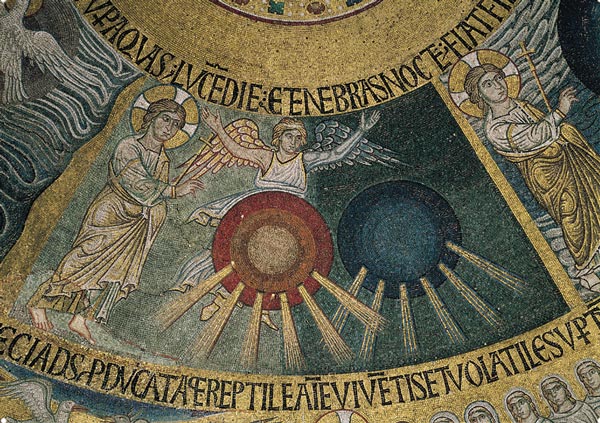
Dumbarton Oaks, Byzantine Photograph and Fieldwork Archives, Washington, D.C.
Recent experiments—using special-purpose telescopes on satellites and balloons, and in such exotic locations as the South Pole—have revealed patterns of very slightly bright and dim patches in the cosmic radiation. These patterns of light reflect patterns of gravity that are left over from the very early universe. Close study of these anisotropies is quantitatively transforming our knowledge of the overall properties of the universe as a whole, giving us precise information on how big it is, how old it is, and what kind of matter and energy it is made of. Here I discuss another transformation, of a more conceptual nature, that has the potential to change how we think about space and time, and matter and energy—how they came to be, and how they are put together.

Tom Dunne
Consider this seeming paradox: The biggest and smallest things in nature are the same things. At first this statement seems to make no sense, yet it is not an obscure metaphor or Zen koan. It is a profound truth about the universe, exactly and literally. It can even be represented by a picture (Figure 3). When we look at the largest structures in the cosmic background radiation—the largest and most distant things we can possibly see, stretching across the whole sky at the edge of the universe—we are looking at patterns that were imprinted in the first moments of creation, when these patterns were single quanta—the smallest amount of something (anything), according to quantum theory—far smaller than the smallest subatomic structure ever seen in the laboratory. Even though we are used to the idea that everything in the universe is connected with everything else, such a literal connection between the quantum world and the cosmic world is surprising. That is because most of the time when we look at large things—anything you can see without a microscope—they look continuous. There is no obvious sign that they are made of discrete microscopic elementary particles. So it is remarkable that when we look at the very largest things, we start seeing the quanta again. The universe expanding all around us acts like a giant microscope.
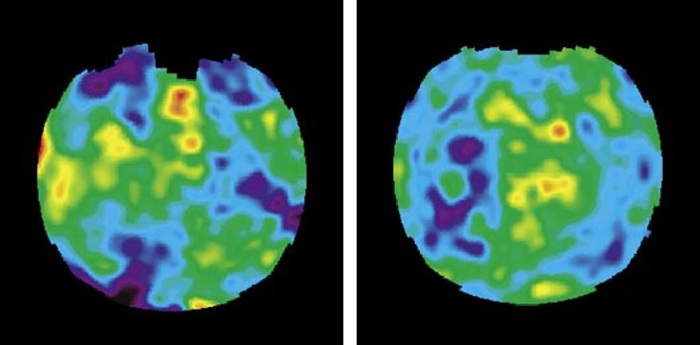
Images courtesy of the COBE Science Working Group.
Here is another seeming paradox about these apparently tiny, strange and exotic fluctuations: These primordial quanta are the most important organizing agent of the universe. The quantum effects from the early universe, at first so subtle, are eventually amplified, first by the inflationary universe and then by their own gravity. Ultimately they determine where all the matter ends up—where galaxies appear and when they collapse out of the expansion, whether a galaxy ends up big or small, at this place or that place. In fact, these fluctuations are responsible for the formation of everything within galaxies, including the stars and planets. The enormous complexity of a whole galaxy grew out of an almost structureless elementary particle.
Strange as these findings may seem, they essentially represent the settled opinion of the cosmological community. Theorists are now thinking about even more curious possibilities. We may soon be able to measure indirectly the quanta of gravity, the gravitons. These are literally "particles of spacetime." Perhaps when we find one we will learn something about how time is put together and the reason it behaves the way it does. We may even be able to detect signs of the quantum discreteness in the states of these particles, equivalent to a kind of "pixelation" of the spacetime continuum. In principle, we might reach the stage where the data are painting a picture not of space and time, and matter and energy as we know them, but of a deeper underlying structure in which these concepts cannot be prized apart. If we ever reach that stage, we will have a glimpse of the beginning of time as it emerged into existence as a property of a more fundamental, irreducibly discrete underlying entity.
Let's consider the universe on the largest scales. Recent observations support a remarkably simple model of the universe as a whole, based on Einstein's (non-quantum) theory of space and time. It appears that space as a whole is very close to uniform and is much larger than the piece of it that we can ever observe (a property we guess from the apparent Euclidean flatness right out to the edge of what we can observe). The entire three-dimensional space has been steadily expanding for about 14 billion years from a much smaller, hotter and denser initial state. (Since we are observing it from inside, we cannot see what it is expanding into!)
The cosmic background radiation has been traveling freely through this expanding space since the universe was less than a million years old, when (because of the expansion) it was a thousand times hotter than it is today. The spectrum of the radiation reproduces to extreme precision the prediction of Big Bang theory, and dates back to the first year of cosmic history. This ancient light has precisely the simplest mixture of colors—a blackbody spectrum, a phenomenon that was first described mathematically by Max Planck a century ago. (His description was the very first piece of quantum physics, but of course Planck knew nothing of the Big Bang and the cosmic background radiation.) The radiation must have been there already much earlier, because the theory also correctly predicts the composition of primordial matter—a simple mixture of hydrogen, helium and lithium isotopes created during the first few minutes of the expansion, starting when the temperature was still over a billion degrees. The accumulated, interwoven evidence is so strong, precise, varied and direct that most cosmologists now regard the Big Bang not as a theory or a model, but as a fact.
The expanding universe at the heart of this model is thought to be given its form by the action of an energy field, the inflaton. With the right properties, the inflaton's interactions can lead to repulsive gravity and create an instability that drives the original expansion of the Big Bang by making everything fly apart from everything else. We think this process of inflation is the way the universe got to be much bigger than an atom. Inflation is what made the Big Bang big.

Images courtesy of Craig J. Hogan.
Now shift to the universe on small scales. The basic structure of everything around us—pizzas, teenagers, bad TV shows—is determined by the way atoms behave. The set of mathematical rules called quantum mechanics, discovered during the 1920s, describes atoms with exquisite precision. Quantum physics tells us that energy always comes in discrete packets, rather than a continuum, and that the packets of energy also behave like waves. These quanta obey the Heisenberg uncertainty principle: The more definitely we know a particle's location (the smaller its wave packet) the greater its momentum tends to be. Elementary particles obey these rules spontaneously, forming identically stable structures such as the nuclei and electron orbitals of atoms with very specific patterns of behavior and structural properties that give the everyday world its regularity and shape (Figure 4). For almost 80 years, scientists have used quantum mechanics as the basis for physics, chemistry and biology because it describes the building blocks of nature. It accounts for everything that happens on the microscopic scales of elementary particles. Photons make light. Quarks, gluons and electrons make atoms. Atoms make molecules. And molecules make pizzas.
Because inflation makes small things big, it creates a new and unexpected role for quantum physics in determining the behavior of the entire universe on the very largest scales. Quantum effects lead to a subtle imprint of inflation on the present-day universe. The inflaton field was not perfectly smooth, but contained imperfections or "fluctuations." The energy that created the universe, like all energy fields, was a quantum field; it came in discrete packets of energy called inflatons, in the same way that light comes in discrete packets of energy called photons, or that atoms are made of discrete elementary particles such as electrons. Quantum fields are never completely at rest—even the emptiest vacuum state is roiling with fluctuations of "virtual particles" emerging and then disappearing back into the vacuum, whose (very real) physical effects are seen clearly in laboratory experiments sensitive to virtual photons. Thus the primordial inflaton could never be perfectly uniform in space. This means that the primordial expansion got a slightly bigger kick in some locations than in others. The effect of a single inflaton quantum was enormously inflated, in the same way that the universe itself was, so a single inflaton left its influence on an astronomically vast tract of space (Figure 5).
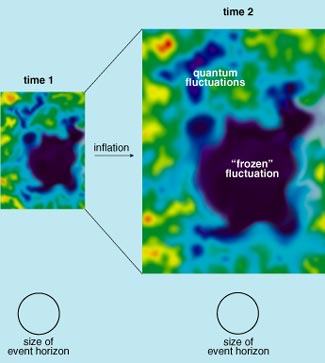
Tom Dunne
The inflaton fluctuations are very important. For one thing, they are the reason that the universe eventually broke up into galaxies, stars and planets. The inflaton fluctuations, frozen into the fabric of space, were converted into very slightly denser and sparser regions of matter. The dense regions eventually collapsed due to gravity. Without these perturbations, the universe would still be perfectly smooth today. Every galaxy we see (even whole clusters of galaxies) ultimately derives from about one elementary inflaton particle in the early universe.
Think about this for a minute. The standard theory now holds that our whole galaxy started its life more or less as a single elementary particle, much smaller than an atom. I used to think this was a crazy idea, but now I am persuaded by high-quality data that it is probably true.
The most persuasive data are the sky maps of the primordial radiation. This cosmic background of light appears almost (but not perfectly) uniform in all directions, with a blackbody temperature of 2.725 degrees (Kelvin) above absolute zero. The gravitational effect of the inflaton perturbations, in addition to creating structures like galaxies, creates patterns on the sky of very slightly hot and cold spots. They are very subtle—temperature differences of less than one part in ten thousand—but the pattern preserves intact primordial information and so far, at the present level of experimental precision, agrees very well with what theory predicts.
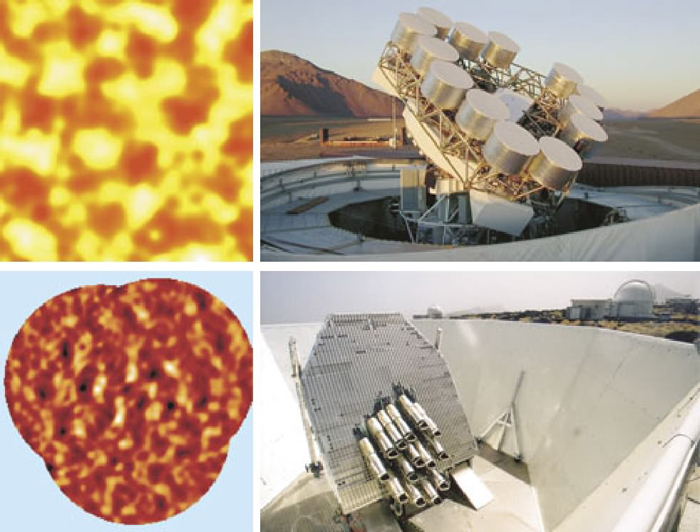
Top images courtesy of Cosmic Background Imager / Caltech / National Science Foundation. Bottom images courtesy of the VSA Collaboration.
About ten years ago, the Cosmic Background Explorer (COBE) satellite made the first observations that convincingly showed primordial structure of this kind. This historic map included the whole sky but was fairly noisy and still rather blurry, with a resolution of about seven degrees. In the past two years, experiments in exotic locations—on high-altitude balloons circling Antarctica and in the high-desert passes of the Andes—have returned low-noise maps of smaller patches of sky with much finer angular detail (Figure 6). A NASA spacecraft called the Microwave Anisotropy Probe (MAP) is now gathering data to produce an all-sky map. (For more information about the MAP mission, see http://map.gsfc.nasa.gov/index.html) Within a year, it should return an extraordinarily detailed map of the temperature fluctuations (Figure 7) as well as the polarization of the radiation. (Just as sunlight is polarized when it reflects off a surface, the microwave background photons were polarized by their encounters with free electrons in the early universe.) A few years from now, a European-led mission called the Planck Surveyor will create an even more detailed map, with even greater accuracy.
The new maps have enough resolution (down to much less than a degree) to show the early universe ringing like the head of a drum, or wiggling like the surface of a pond, in response to the small kick from the primordial perturbations. The precision of the data now allows measurement of many cosmological parameters, including the density of matter and the global curvature of space, to an accuracy of a few percent—the beginning of true "precision cosmology." We even have precise data about some parameters of the inflaton field, a new force of nature, which has not been observed in any other way.
In addition to the inflaton perturbations, quanta of another field are created during inflation—those of gravity itself. These may also leave imprints on spacetime and the background anisotropy today, in the form of large-scale gravitational waves. Neither gravitational waves nor gravitons have yet been observed, but they are a form of energy predicted in Einstein 's theory of spacetime. As it does with the inflaton quanta, inflation takes single graviton quanta and stretches them to great size. Starting with observing campaigns such as MAP, one strategy to tease apart the inflaton and the graviton fluctuations is to seek certain patterns of polarization that can only be created by gravitons. (It's likely that gravitational waves, though not individual quanta and probably not from inflation, will be soon detected, for the first time and at much higher frequencies, by new laser interferometers, such as LIGO, now coming into operation.)
Inflationary cosmology assumes that basic spacetime is the way Einstein built it before quantum mechanics came along—a smooth and unbroken (if slightly perturbed) continuum, with quantum fields playing within it. At some level, though, we know this cannot be right. Quantum discreteness must come into play even in the structure of time and space. Perhaps the sky is painted with a pattern that contains clues to how this works.
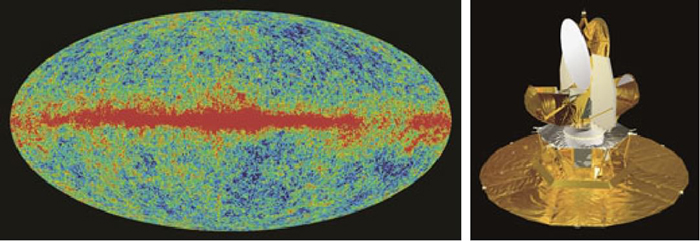
Images courtesy of the NASA and the MAP Science Team.
Let's think about the information contained in such a pattern. Information content roughly corresponds to the size of the computer file needed to store, say, a picture or a sound. In standard inflation theory, the pattern on the sky is predicted to have an infinite amount of information, because in theory the variations in brightness are continuous noise. But a truly quantum cosmology may have a finite amount of information. If the amount of information during inflation is small enough, it may be smaller than the information content of the maps we make—in which case, the maps will show signs of quantum discreteness.
If your computer modem is new, it is very fast, and it carries so much information it sounds like random noise. With older, slower modems you could hear the pattern of tones, so it was obvious that the signals were discrete and carried a certain limited quantity of information.
If you look at a digital picture or an ancient mosaic up close you can see it break up into discrete elements. Each pixel (or each tile) has a uniform color and is selected from a limited inventory of choices. Similarly, although we have yet to find the pixelation of spacetime itself, we suspect that it is there at some level, and may first appear in the close-up view of quanta afforded by inflation.
Deep insights into the connection between quantum physics and spacetime physics come from the consideration of information flow in black holes. A black hole is made not of matter but of highly curved spacetime. Inside a roughly spherical, imaginary surface in space called an event horizon (with its size depending on the hole's mass), gravity (spacetime curvature) is so intense that no energy, not even light, can escape—except by quantum behavior. A quantum always has some spatial extent, so it always has some chance of being far enough away from the hole to escape its gravity. Thus a black hole actually radiates energy, and by doing so it converts pure "spacetime energy " (gravity itself) into other forms, such as light.The theory of black hole evaporation, developed by Stephen Hawking, Jacob Bekenstein and others, allows us to predict just how many particles are radiated by a black hole and what their energies are. It turns out that the maximum amount of information needed to completely describe everything that falls into a black hole is a very simple recipe. It is just one-quarter of the area A of the event horizon, expressed in Planck units (where G, the gravitational constant, h, the Planck constant, and c, the speed of light, are all equal to 1). Put another way, the state of a black hole—everything that could possibly be known about it, the result of any conceivable experiment—can be specified by a number that has n = A/4 ln 2 binary digits. (The natural logarithm of 2 factor is there if we measure information in bits rather than "natural" entropy units.)
We can think of spacetime itself as an active quantum object. In this view, Hawking radiation converts quanta of spacetime (gravity) into quanta of other forms of information-carrying energy. The beauty of this is that it gives us a precise handle on the numerical relationship between gravity and information, and therefore a quantitative estimate of the quantization of spacetime.
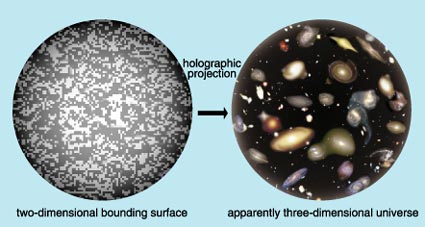
Tom Dunne
Based on such arguments, it has been argued, especially by Gerard 't Hooft of the University of Utrecht and Leonard Susskind of Stanford University, that physics must obey a "holographic principle"—the entire state of things in any three-dimensional volume can be specified by a finite quantity of information less than one-quarter of the area of a two-dimensional bounding surface (one that covers the three-dimensional volume). They conjecture that the world is like a hologram. In a conventional optical hologram an interference pattern generated by two laser beams is recorded on a two-dimensional piece of film. When the developed film is illuminated with another laser beam, the recorded information is reconstructed, projecting a three-dimensional image of the original object. 't Hooft and Susskind suggest that the universe seems to be three-dimensional to us, but at a deeper level it is "really" just happening on a two-dimensional projective surface (Figure 8). But there's more. The surface is not even continuous, but grainy—the hologram is made of discrete pieces like a mosaic. So there is vastly less information than one would have guessed from quantum mechanics and gravity considered separately.
Inflationary universes also have event horizons (they are rather like inside-out versions of black hole event horizons), and the maximum observable information is also one quarter of the area of the event horizon. This means that the range of different things that can happen during inflation is much less than predicted if one assumes that spacetime does not respond in a quantum way. In particular, the holographic constraint means that when the inflaton field fluctuates, it finds its options severely limited, in ways that may be observable. Thus the cosmic background radiation anisotropy may be our first example of a phenomenon yielding direct information on the operation of quantum gravity—whether that be something like string theory or another more fundamental set of ideas.
The quantum rules governing the hydrogen atom are very simple and compelling, but they would never have been guessed without detailed data on the rich and complicated spectra that reflect the energies of the discrete stable states of atoms. Perhaps we will similarly be able to peer into the quantum nature of spacetime with images of the microwave background anisotropy and use that to figure out how it all works.
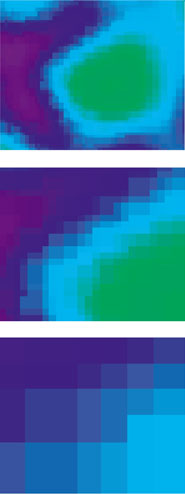
Images courtesy of Craig J. Hogan.
Although the maps of the sky contain a great deal of information—and promise more with the forthcoming results—they may also contain profoundly little information in a technical sense. Simple models of holographic inflation suggest that the total amount of information available to the quanta that form the background may be relatively modest—perhaps the equivalent of less than a million pixels, or roughly the amount of information displayed in your personal computer display. It's a lot less information than the maps we will be making, so we may be able to notice the information limit imposed by the universe (Figure 9). If so, the graininess in the picture, or whatever special atom-like quantum patterns emerge, will be a direct sign of the holographic quantization of spacetime. For all practical purposes, we could accurately call this a view of the true beginning of time, since we would be penetrating beyond "ordinary" time to some more fundamental, discrete structure from which our apparently continuous time and space have emerged.
Full disclosure: We should not think of primordial discreteness as some sort of Holy Grail that will provide answers to all the mysteries of creation. Equating interest and information content, the beginning of time is actually a lot less interesting than what came after. The evidence we have already suggests that the universe began with almost no information, and all the complex structure within it has developed since the beginning, on its own, without external influences. If this is true, finding the beginning of time and even its detailed structure will not help us much to understand the interesting things that have happened within the universe since then.
Click "American Scientist" to access home page
American Scientist Comments and Discussion
To discuss our articles or comment on them, please share them and tag American Scientist on social media platforms. Here are links to our profiles on Twitter, Facebook, and LinkedIn.
If we re-share your post, we will moderate comments/discussion following our comments policy.